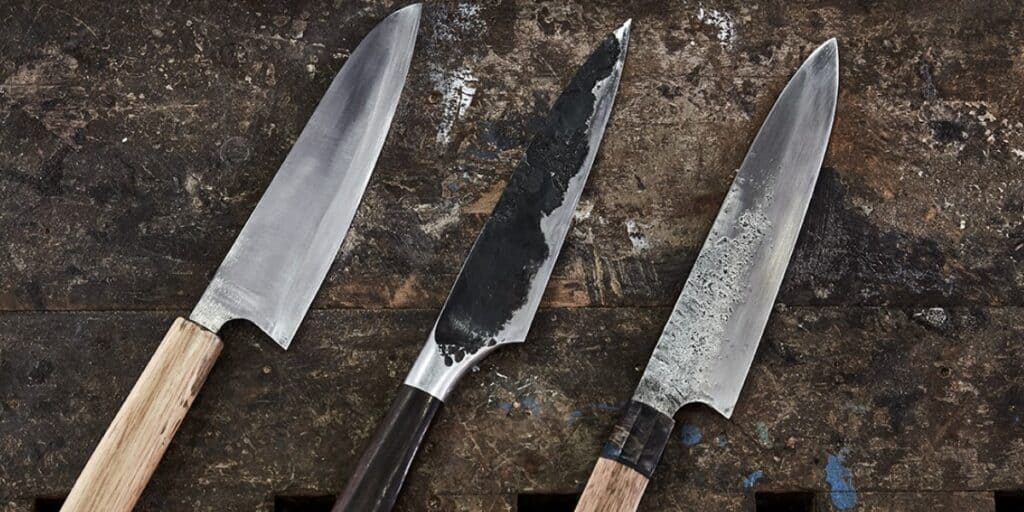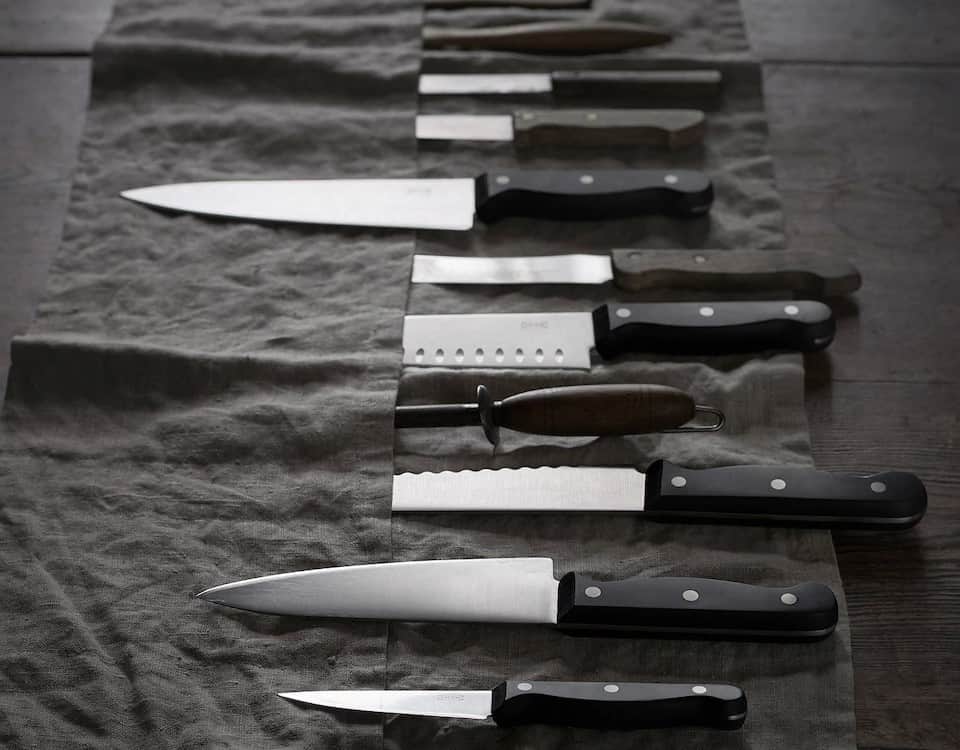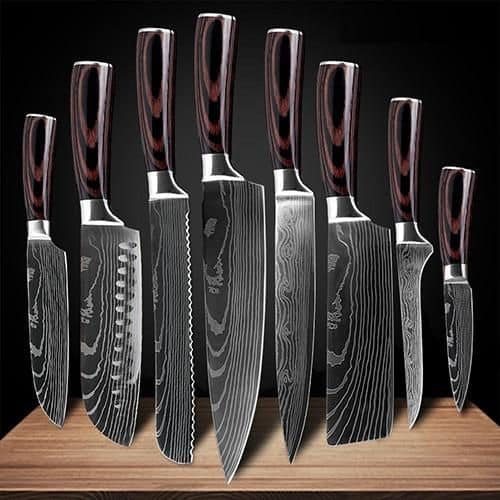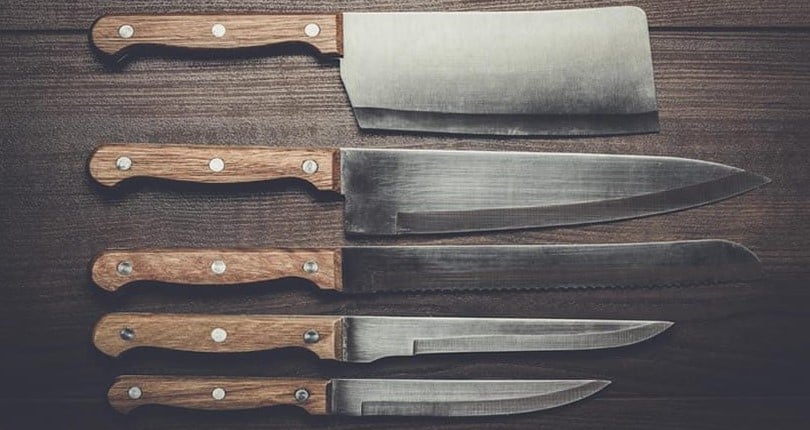There is a multitude of types of kitchen knives to choose from when picking the right knives for you. This host of choices might give you a hard time deciding which knives suit your needs. Arm yourself with the knowledge of the types of kitchen knives, and you will find the right knives for all your kitchen needs.
In finding the right knife, ask yourself what you use knives for the most. Some knives are best for kitchen work that does a lot of slicing, dicing, and mincing. Some knives perform best for peeling or cutting fruits and vegetables, and some are just straight-up chopping machines! If you do a little of everything, there are some knives that are best at doing just that. Knowing what knives go best with how you use them goes a long way in having an easier and more enjoyable time in the kitchen.
Kitchen Knife Anatomy: The Different Parts of a Kitchen Knife and Its Functions

You might think that learning about a knife’s different parts doesn’t add value to you as a cook, but knowing them affects how a knife handles and feels in your hand will play a big part in how easy your time will be in the kitchen.
Each part serves a specific purpose, and knowing every knife part will give you the ability to pick the right knife according to your personal handling preferences and the kitchen work you do. This way, you are sure each knife you acquire will give you a more enjoyable time cooking.
Here is a comprehensive list of Basic Knife Parts and their functions:
- The Edge – The business end of the knife, the cutting side. Can also be called the grind of your knife, which refers to the kind of blade.
3 Types of Grinds:
-
- Hollow Grind – The common chef’s knife is usually a hollow grind and is the sharpest kind of edge to accommodate clean, smooth cuts that are good for slicing, light chopping, and filleting. These tend to be lighter and more delicate blades and will break or chip if used for heavy chopping.
- Serrated Grind – The bread knife and steak knives are examples of this grind. The saw-like edge on the blade lends you more leverage to shear through tough foodstuff like bread and meats.
- Flat Grind – The Heavy-duty, full-bodied edge that is less sharp than the hollow grind, but is tougher and makes cuts through cartilage and bone very easy. Meat cleavers are examples of these.
- The Tip and Point – These two are easily mistaken for each other. The point is where the sharpened edge and the spine meet, while the tip is the last inch or two of a knife blade. How the point is designed usually tells you what the knife is used for. Kitchen knives normally have a drop point. Drop points have the edge and spine gently curving into each other. These points are good for slicing and chopping.
- The Spine – The dull edge of the blade that holds most of the knife’s weight. The thicker the spine, the better it will do with heavy chopping. The thinner the spine is, the better it will do with delicate or accurate slicing, cutting, and chopping.
- The Handle – May be made from a variety of materials like wood, plastic, Teflon, or metal. Choosing a knife handle depends entirely on what you feel comfortable with. Some handles come with grooves to give you a better grip. Whichever handle you go for, be sure to pick the one that feels right in your hand. The handle is also called the scales of the knife.
- The Tang – The part of the blade that is hidden within the handle. The more tang in the handle, the more durable the knife will be. Full tangs, which are the most durable, run the whole length of the handle. Partial tangs, run only up to half the handle. Partial tang blades are used for more delicate chef work, while full tangs are usually cleavers and heavy chopping knives.
- The Bolster – This reinforces the part where the handle and the blade meet. It also serves as a protective guard that stops your hand from slipping onto your knife’s edge.
- The Handle Fasteners – Are either screws or rivets. Screw knife fasteners need to be regularly tightened, while rivets are a fixed type of fastener and don’t need any type of maintenance, but are a bit of a hassle when you need to replace the handle. Screws, on the other hand, make handle replacement a breeze.
The Main Types of Kitchen Knives and Their Uses
Knowing about the types of knives available and understanding their proper uses will be essential in having excellent knife work. A knife that cuts one type of food may not be too efficient on others. Read on to know what each type of knife is specialized for.
We will be grouping knives into four major categories, namely Chef, Meat, Fish, and Vegetable knives, for most knives we use fall under them.
Chef Knife Set
This category includes knives that a chef or cook uses to prepare a vast variety of foods; from fruits and vegetables, bread, fish, and meat. Chef’s Knives of this sort allow you to tackle virtually all cutting challenges with ease.
- The Chef’s Knife – The quintessential kitchen knife, all cooks, professional or otherwise, own a dependable Chef’s Knife. Its versatility makes the Chef’s Knife an indispensable tool in every kitchen. Own one of these, and you’d probably be able to use it in cooking anything you want! If you were to just own one knife, pick a good quality Chef’s Knife.
-
- These usually have an 8 to 10-inch-long broad blade that has its edge and spine gently tapering to a drop point. This general shape allows the cook to use this cooking knife in a variety of cutting, mincing, and chopping applications, such as dicing potatoes to cutting chicken.
-
- Choose one that has a full tang for durability and stability, because these will be the knives you will use the most.
- The Paring Knife – These are small knives that are usually used for precise cutting work on delicate foods like creating garnishing, peeling and deseeding fruits or vegetables, or any decorative work that only a tiny knife can do.
-
- A Paring Knife’s blade usually ranges from 2.5 to 4 inches long to allow its user more control and precision. It has a pointed spear-like point for easy slicing and deseeding.
- The Utility Knife – This knife is supposed to handle kitchen work that a chef’s knife is too big to do and work a paring knife is too small to do. The utility knife stands as the kitchen’s spare knife, more than anything.
-
- In all practicality, people just have these knives just in case. These awkwardly sized knives, usually 5-7 inches long are only used when you lose your chef’s knife for some reason. But otherwise, you won’t remember the last time you chose to use these so-called utility knives over your trusty chef’s knife or paring knife.
- The Bread Knife – As its name implies, the Bread Knife is the only knife that will find success in slicing bread. Its serrated edge lends you additional shearing power in slicing soft, delicate foods that will get crushed under other straight edge knives.
-
- The serrated blade on the usual bread knife is 10-15 inches long and is not just useful for slicing bread. They also make carving a turkey and slicing roasts much easier.
- Bread knives are also perfect for slicing tomatoes and other delicate fruit like persimmon. Saw open a jackfruit with these knives, too.
Meat Knife Set
This category includes all the blades you need when dealing with meat. Knives of this category are best for chopping, slicing, boning, and cutting meat.
- The Boning Knife – This meat knife is specially made for separating meat from the bone. These can also be used to prepare and cut up meat and fillet fish.
-
- Boning knives are 4 to 8 inches long and are typically built thinner rather than broader. This shape helps with making easy precise cuts and slices that broader blades can’t do.
- Professional cooks prefer the more flexible Boning knives because the flexibility lends them a more adaptable blade for those more challenging cuts of meat.
- The Cleaver – A heavy hunk of a knife, the cleaver is the biggest, broadest knife in any kitchen’s knife set. The cleaver is so designed to take on the heaviest of tasks, like chopping through bones, chopping large pumpkins, and cutting anything in one fell swoop.
-
- Cleavers are usually 8-10 inches long and are 5-6 inches wide. They have a thick heavy spine and are constructed with a full tang for durability and reliability.
- Their broad blades make crushing garlic very simple.
- The Carving Knife – These are specialized knives designed to slice through large pieces of cooked meat like turkey or pork. These narrow and long blades give you an easier time when slicing through wider pieces of meat.
-
- Carving knives are around 12-16 inches long to make for long strokes that produce thin and neat slices when carving meat.
- Carving knives are also handy for slicing up large fruit like watermelons, melons, and jackfruit.
Fish Knife Set
Fish knives are specialized in cutting, slicing, and filleting fish.
- Salmon Knife – These are very long, narrow knives that are used to slice thin, even pieces of salmon.
-
- Modern salmon knives have a rounded tip to avoid damaging the fish.
- They are around 11-15 inches long, just over an inch wide, and built to be flexible to help with making precision cuts.
- Fillet Knife – Extremely narrow knives that are used to fillet thin and even slices of fish.
-
- These sharp knives are around 7 inches long and have a very sharp edge and a pointed tip to pierce fish’s skin.
- Fillet knives look similar to boning knives but differ in how they are thinner and more flexible. Its design aids in delicately removing fish bones without damaging the rest of the fish.
Vegetable Knife Set
Vegetable knives are a set of knives that perform a cut above the rest of the average kitchen knives when it comes to cutting, chopping, and preparing vegetables.
- Peeling Knife – These are short blades that have a straight edge, a slightly inward-curving blade, and a talon tip.
-
- These handy little knives are usually 3-5 inches long, an inch wide, and are used to peel, slice, and prepare fruit and vegetables.
- Tomato Knife – As the name suggests, these specialized knives are used to thinly slice tomatoes or other delicate fruit without damaging their flesh. Not many know of this, but tomatoes are one of the main reasons our straight-edged knives become dull. Straight edge knives have a hard time latching on to the smooth skin of tomatoes and are just dulled on a microscopic level.
-
- These are 6-7 inches long and have a serrated edge to help them latch on tomatoes’ smooth skin, making it easy for thin, even slices without crushing their delicate flesh.
- Nakiri Knife – Also known as the Japanese Vegetable Knife, these knives look like slimmer, smaller cleavers. Their rectangular, broad blade and substantial weight make it good for chopping vegetables without the need for rocking the knife back and forth.
-
- The blade on these knives is usually 5-8 inches long and is perfect for cutting larger and harder vegetables like squash and sweet potatoes.
- The flat blade of the Nakiri knife makes it perfect to shred or thinly slice vegetables like cabbage, carrots, zucchini, and different herbs.
- Santoku Knife – This knife of Japanese origin looks like a cross between a Chef’s Knife and a Nakiri knife. Its edge is mostly straight and curves upward toward the tip. It is almost as broad as the Nakiri but is thinner to allow more refined cuts and slices.
-
- These 6–8-inch blades are best used for slicing meat, chopping fruit and vegetables, mincing herbs, and making fine decorative slices of fruit or seafood for garnish.
- The broader, straight blade of the Santoku knife allows you to scoop up the food you have prepared straight off of your chopping board. A very useful trick when you aim for fast food preparation.
Things to Consider When Choosing a Knife
They say the kitchen knife is the soul of a good cook. That is why you must choose the best knife specifically for you. Follow these three tips and do not fall for every marketing ploy of knives that claims to be the best.
- Your Hands’ Size – The comfort of how your knife handles depends on how well your hand fits your knife. Choose the knife that feels right when you hold it. The knife you choose should not be too heavy and must feel balanced when you wield it.
- A Sharp Edge – Choose a knife made of quality materials. Avoid blades that claim to not need any sharpening. There is no such thing because ALL knives need sharpening to maintain their cutting edge.
- How Many Knives Do I Need? – The number of knives you include in your knife set collection depends on what kitchen work you regularly do. It is very easy to fall into the trap of collecting and purchasing a myriad of beautiful knives that we never really get to use. Just remember that the best knife is the knife you use regularly.
Knives for Better Cooking
Learning about all the different knives and their uses will make food preparation in your kitchen efficient, safe, and enjoyable. Better cuts, slices, and dices of food will surely improve your dishes’ taste, presentation, and quality!
Feel confident in adding a few more blades to your kitchen knife collection as long as you use them regularly in your cooking.

Gary Portman is the founder and main author of Knivesadvice.com. With his extensive knowledge and experience, he is committed to assisting people in choosing the perfect knife for their needs. Through his articles, Gary shares valuable insights on various aspects of knives. With his expertise, readers can make informed decisions and find a knife that is tailored to their preferences and requirements. You can find more info about Gary here.





